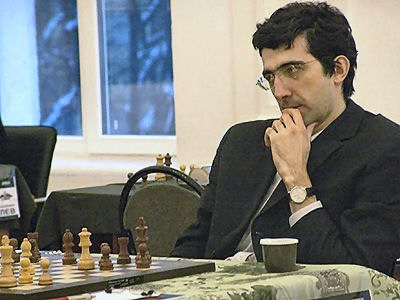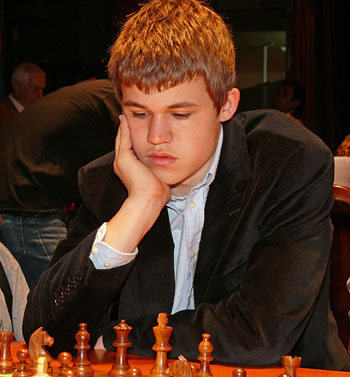| Latest | Greatest | Lobby | Journals | Search | Options | Help | Login |
|
|
|
This topic is archived. |
| Home » Discuss » Topic Forums » Sports |
|
| Jack Rabbit
|
Sun Jul-12-09 02:33 PM Original message |
| The JR Chess Report (July 12): Kramink Wins Dortmund |
|
Kramnik wins in Dortmund
 Former world champion Vladimir Kramnik of Russia won the 2009 edition of the Sparkassen Chess Meeting Grandmaster Tournament today with 6� points in ten rounds, a full point ahead of three rivals who tied for second. To wrap up the tournament, Kramnik won his final game against German GM Arkadij Naiditsch. It was the former champ's third victory of the event. He drew his other seven games. Norwegian GM Magnus Carlsen, Russian Dmitry Jakovenko and Peter Leko of Hungary tied for second with 5� points each. Magnus and Jakovenko each won two, lost one and drew seven while Leko won a single game without a loss while drawing nine. Kramnik was world champion from 2000, when he defeated the legendary Garry Kasparov in a match held in London, until 2007, when he lost the title in a tournament held in Mexico City that was won by the current champion, Vishy Anand of India. Anand also defeated Kramnik in a title match in Bonn, Germany, in 2008. This is Kramnik's ninth Dortmund title. Nakamura leads Donostia-San Sebasti�n after 5  Reigning US champion Hikaru Nakamura leads the grandmaster tournament in San Sebasti�n (Donostia in Basque) after five rounds with 4� points. Nakamura scored a victory today with Black over Spanish GM Pablo San Segundo in 54 moves. Ruslan Ponomariov of Ukraine and Russian GM Peter Svidler are tied for second with 3� points points each. The tournament concludes after the ninth round Thursday. San Sebasti�n, the site of two historic tournaments in the early twentieth century, is located in the Basque region of Spain in the far northeast of the coutry, near where the Franco-Spanish frontier meets the Bay of Biscay. Calendar Canadian Open, Edmonton 11-19 July. Czech Open, Pardubice 16 July-2 August. Biel Chess Festival 19-30 July. This year's GM Tournament is a Category 19 that includes Morozevich, Ivanchuk, Gelfand, Alekseev, Vachier Lagrave and Caruana. Pan-American Continental Championship, S�o Paulo 25 July-2 August. Mainz Chess Classic 27 July-2 August. US Open, Indianapolis 1-9 August. FIDE Grand Prix, Yerevan 8-24 August. Howard Staunton Memorial, London 8-17 August. Played at historic Simpson's Divan. International Festival d'�checs, Montreal 27 August-7 September. Grandmaster Tournament will include Bacrot, Onischuk, Shulman, Naiditsch and Maze; more to be added. Grand Slam Final, Bilbao 2-15 September. Topalov, Karjakin, Grischuk and Shirov qualify. Second Pearl Spring Tournament, Nanjing 27 September-9 October. Topalov, Anand, Carlsen, Radjabov, Jakovenko and Wang Yue. World Junior Championship, Mar del Plata (Argentina) 16-29 October. European Club Cup (Team Championship), Novi Sad (Serbia) 21-31 October. World Cup, Khanty Mansiysk 28 November-15 December. London Chess Classic 7-16 December. Corus Chess Tournament, Wijk aan Zee 15-31 January 2010. Nakamura has been invited to play in group A. Anand-Topalov Match for the World Title, Site TBA c. April 2010. |
| Printer Friendly | Permalink | | Top |
| Jack Rabbit
|
Sun Jul-12-09 02:50 PM Response to Original message |
| 1. This week's games |
|
Your humble hare acknowledges the assistance of Fritz 6.0 on analysis. Diagrams on the Jack Rabbit Chess Report are made with Chess M�rida, a true type font that can be downlaoded free here. !""""""""# $tMvWlVmT% $OoOoOoOo% $ + + + +% $+ + + + % $ + + + +% $+ + + + % $pPpPpPpP% $RnBqKbNr% /(((((((() WHITE White to move (This position is a theoretical draw) |
| Printer Friendly | Permalink | | Top |
| Jack Rabbit
|
Sun Jul-12-09 02:51 PM Response to Reply #1 |
| 2. Sparkassen Chess Meeting, Dortmund |
| Printer Friendly | Permalink | | Top |
| Jack Rabbit
|
Sun Jul-12-09 02:54 PM Response to Reply #2 |
| 3. Kramnik - Carlsen, Round 8 |
 Vladimir Kramnik Vladimir Kramnik - Magnus Carlsen Sparkassen Chess Meeting, Round 8 Dortmund, 10 July 2009 Orthodox Queen's Gambit: Blackburne Opening 1.d4 d5 2.c4 e6 3.Nf3 Nf6 4.Nc3 Be7 5.Bf4 0-0 6.e3
6...c5 7.dxc5 Bxc5 8.a3 Nc6 9.Qc2 Qa5 10.Rd1
10...Be7 11.Be2
11...dxc4 12.Bxc4 Nh5 13.0-0
13...Nxf4 14.exf4 g6!?
15.g3
15...Rd8 16.Rxd8+ Qxd8 17.Rd1 Bd7
18.f5!?
18...gxf5
19.Qd2 Qb6!?
!""""""""# $t+ + +l+% $Oo+vVo+o% $ Wm+o+ +% $+ + +o+ % $ +b+ + +% $P N +nP % $ P Q P P% $+ +r+ K % /(((((((() WHITE: Vladimir Kramnik Position after 19...Qd8b6 20.Qh6!
20...Be8
21.Ng5!
21...Bxg5
22.Qxg5+ Kf8 23.Qh6+ Kg8 24.Qg5+ Kf8 25.Rd6 Qc7?
!""""""""# $t+ +vL +% $OoW +o+o% $ +mRo+ +% $+ + +oQ % $ +b+ + +% $P N + P % $ P + P P% $+ + + K % /(((((((() WHITE: Vladimir Kramnik Position after 25...Qb6c7 26.Qh6+!
26...Ke7 27.Qh4+ Kf8 28.Qh6+ Ke7 29.Nb5!
29...Qa5 30.b4 Nxb4
!""""""""# $t+ +v+ +% $Oo+ Lo+o% $ + Ro+ Q% $Wn+ +o+ % $ Mb+ + +% $P + + P % $ + + P P% $+ + + K % /(((((((() WHITE: Vladimir Kramnik Position after 30...Nc6b4:p 31.Rxe6+!!
31...fxe6 32.Qxe6+ Kd8 33.Qf6+ Kc8 34.Qxf5+ Kd8 35.Qf6+ Kc8 36.axb4 1-0
|
| Printer Friendly | Permalink | | Top |
| Jack Rabbit
|
Sun Jul-12-09 06:06 PM Response to Reply #2 |
| 8. Carlsen - Naiditsch, Round 5 |
|
Magnus took the sole lead by winning this game and held it until losing to Kramnik (see game above) in the eighth round.
 Magnus Carlsen Magnus Carlsen - Arkadij Naiditsch Sparkassen Chess Meeting, Round 5 Dortmund, 6 July 2009 Spanish Petit Royal Game: Gothic Defense (Berlin Defense) 1.e4 e5 2.Nf3 Nc6 3.Bb5 Nf6 4.0-0 Nxe4 5.d4 Nd6 6.Bxc6 dxc6 7.dxe5 Nf5 8.Qxd8+ Kxd8 9.Nc3 h6
10.h3 Ne7
11.Bf4
11...Ng6 12.Bg3 Ke8
13.Rad1 Bb4 14.Ne2!
14...h5
15.Ned4 h4
16.Bh2 Nf8
17.Bf4 Bd7 18.Bg5 Be7 19.Rfe1 c5 !""""""""# $t+ +lM T% $OoOvVoO % $ + + + +% $+ O P B % $ + N + O% $+ + +n+p% $pPp+ Pp+% $+ +rR K % /(((((((() WHITE: Magnus Carlsen Position after (move) 20.e6!
20...fxe6 21.Bxe7 Kxe7 22.Nf5+ Kf6 23.Ne3!
23...Be8 24.Ng4+ Ke7 25.Nge5 Bg6!?
!""""""""# $t+ + M T% $OoO L O % $ + +o+v+% $+ O N + % $ + + + O% $+ + +n+p% $pPp+ Pp+% $+ +rR K % /(((((((() WHITE: Magnus Carlsen Position after 25...Be8g6 26.Rd5!
26...b6!
27.Rd2 Bf5 28.Ng5
28...Kf6
29.f4 Ng6 30.Nd7+
30...Ke7 31.Nxe6 Bxe6 32.f5 Nf4
33.fxe6 Rhd8 34.Rf2 g5
35.Kh2
35...a5 36.a4
36...Rg8 37.Ne5 Rae8 38.Nf3 Nxe6 39.Re5!?
39...Kd6
40.Rd2+ Kc6 41.Rde2 Kd6?
!""""""""# $ + +t+t+% $+ O + + % $ O Lm+ +% $O O R O % $p+ + + P% $+ + +n+p% $ Pp+r+pK% $+ + + + % /(((((((() WHITE: Magnus Carlsen Position after 41...Kc6d6 42.Nxg5!
42...Ng7
43.Rxe8 Rxe8 44.Rxe8 Nxe8 45.Nf3!
45...c4 46.Nxh4 c3 47.b3 Kc5 48.Nf5 Kb4 49.g4 Ka3
50.Kg3 Kb2 51.Ne3 Kc1 52.Kf3 Kd2 53.h4 Ng7
54.h5 Ne6 55.h6 c6 56.Ke4 b5
57.Ke5 Ng5 58.Kf5 Nf7 !""""""""# $ + + + +% $+ + +m+ % $ +o+ + P% $Oo+ +k+ % $p+ + +p+% $+pO N + % $ +pL + +% $+ + + + % /(((((((() WHITE: Magnus Carlsen Position after 58...Ng5f7 59.h7!!
59...Kxe3 60.g5 1-0
|
| Printer Friendly | Permalink | | Top |
| Jack Rabbit
|
Sun Jul-12-09 03:36 PM Response to Reply #1 |
| 4. Donostia Chess Festival, San Sebasti�n |
| Printer Friendly | Permalink | | Top |
| Jack Rabbit
|
Sun Jul-12-09 03:37 PM Response to Reply #4 |
| 5. Nakamura - Vachier Lagrave, Round 2 |
 Hikaru Nakamura Hikaru Nakamura - Maxime Vachier Lagrave Donostia Chess Festival, Round 2 San Sebasti�n, 8 July 2009 Open Sicilian Game: Najdorf-Scheveningen Defense (Chandler-Nunn Opening) 1.e4 c5 2.Nf3 d6 3.d4 cxd4 4.Nxd4 Nf6 5.Nc3 a6 6.Be3 Ng4
7.Bc1
7...Nf6 8.f3 e6 9.Be3 b5 10.Qd2 Nbd7 11.g4 h6 12.0-0-0 Bb7 13.h4
13...b4 14.Na4 Qa5 15.b3 Nc5 16.a3 Rc8
17.Qxb4!
17...Qc7
18.Nxc5!?
18...dxc5 19.Qa4+ Nd7!
20.Ne2 Bc6 21.Qc4!?
!""""""""# $ +t+lV T% $+ Wm+oO % $o+v+o+ O% $+ O + + % $ +q+p+pP% $Pp+ Bp+ % $ +p+n+ +% $+ Kr+b+r% /(((((((() WHITE: Hikaru Nakamura Position after 21.Qa4c4 21...Ne5!
22.Qc3
22...Nxf3 23.Bf4 e5?
24.Qxf3 exf4 25.Qxf4!?
25...c4 26.b4 a5
27.Qxc7 Rxc7 28.c3!?
28...Bxe4 !""""""""# $ + +lV T% $+ T +oO % $ + + + O% $O + + + % $ Po+v+pP% $P P + + % $ + +n+ +% $+ Kr+b+r% /(((((((() WHITE: Hikaru Nakamura Position after28...Bc6e4:p 29.Rh3!
29...Be7 30.Nd4 axb4 31.axb4 0-0
32.Nb5!
32...Rb7
33.Nd6 Bxd6 34.Rxd6 Rc7
35.Rd4 Bb7
36.Rxc4 Re7
!""""""""# $ + + Tl+% $+v+ ToO % $ + + + O% $+ + + + % $ Pr+ +pP% $+ P + +r% $ + + + +% $+ K b + % /(((((((() WHITE: Hikaru Nakamura Position after 36...Rc7e7 37.Rd4
37...Re1+ 38.Rd1 Rfe8 39.Bd3 Bc8 40.Rg3 g5 41.hxg5 hxg5
42.Rxe1 Rxe1+ 43.Kd2 Re5 44.Re3 1-0
|
| Printer Friendly | Permalink | | Top |
| Jack Rabbit
|
Sun Jul-12-09 04:16 PM Response to Reply #4 |
| 6. Vachier Lagrave - Svidler, Round 4 |
 Peter Svidler Maxime Vachier Lagrave - Peter Svidler Donostia Chess Festival, Round 4 San Sebasti�n, 11 July 2009 Spanish Grand Royal Game: Marshall Gambit 1.e4 e5 2.Nf3 Nc6 3.Bb5 a6 4.Ba4 Nf6 5.0-0 Be7 6.Re1 b5 7.Bb3 0-0 8.c3 d5 9.exd5 Nxd5 10.Nxe5 Nxe5 11.Rxe5 c6
12.d4
12...Bd6 13.Re1 Qh4 14.g3 Qh3 15.Re4 15...g5 16.Qf1 Qh5 17.Nd2 f5 18.Re1!? 18...f4 19.Bd1? 19...f3! 20.Ne4 20...Bh3 21.Qd3 Rae8 22.Bd2 !""""""""# $ + +tTl+% $+ + + +o% $o+oV + +% $+o+m+ Ow% $ + Pn+ +% $+ Pq+oPv% $oP B P P% $R +bR K % /(((((((() WHITE: Maxime Vachier Lagrave Position after 22.Bc1d2 22...Rxe4!! 23.Qxe4 Bxg3! 24.Bxf3 24...Bxh2+ 25.Kxh2 Bg4+ 26.Kg1 Bxf3 27.Qe6+ 27...Kg7 28.Qe5+ Rf6 29.Qh2 Rh6 0-1 |
| Printer Friendly | Permalink | | Top |
| Jack Rabbit
|
Sun Jul-12-09 04:22 PM Response to Reply #4 |
| 7. Vachier Lagrave - Karpov, Round 3 |
| Printer Friendly | Permalink | | Top |
| Jack Rabbit
|
Wed Jul-15-09 12:42 AM Response to Original message |
| 9. Update (Tuesday): Canadian Open Begins in Edmonton; 5 perfect after 4 rounds |
|
Edited on Wed Jul-15-09 12:49 AM by Jack Rabbit
 The annual Canadiian Open Chess Championship began in Edmonton, Alberta Saturday and will run through Sunday, July 19. After four rounds, five players are tied for first place with perfect scores: grandmasters Ni Hua (China), Surya Shekhar Ganguly (India), Victor Mikhalevski (Israel), Mark Bluvshtein (Canada), and federation master Raja Panjwani (Canada). The top seeded man in the tournament, Spanish GM Alexei Shirov, and the top seeded woman, Zhao Xue of China, began the fourth round with perfect scores and faced each other over the board. The game ended in a draw after 21 moves. Games are covered live on the official website (Monroi). Action begins at 6 pm MDT (5 pm PDT) tomorrow, Thursday and Friday, 4 pm MDT (3 pm PDT) Saturday and 12 noon MDT (11 am PDT) Sunday. |
| Printer Friendly | Permalink | | Top |
| DU
AdBot (1000+ posts) |
Wed May 01st 2024, 06:33 PM Response to Original message |
| Advertisements [?] |
| Top |
| Home » Discuss » Topic Forums » Sports |
|
Powered by DCForum+ Version 1.1 Copyright 1997-2002 DCScripts.com
Software has been extensively modified by the DU administrators
Important Notices: By participating on this discussion board, visitors agree to abide by the rules outlined on our Rules page. Messages posted on the Democratic Underground Discussion Forums are the opinions of the individuals who post them, and do not necessarily represent the opinions of Democratic Underground, LLC.
Home | Discussion Forums | Journals | Store | Donate
About DU | Contact Us | Privacy Policy
Got a message for Democratic Underground? Click here to send us a message.
© 2001 - 2011 Democratic Underground, LLC